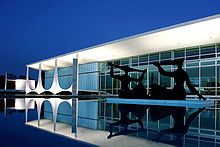
Back Arquitectura de Brasil Spanish Architecture brésilienne French אדריכלות בברזיל HE Arquitetura do Brasil Portuguese Arhitektura Brazilije Slovenian


| Part of a series on the |
| Culture of Brazil |
|---|
 |
| Society |
| Topics |
| Symbols |
The architecture of Brazil is influenced by Europe, especially Portugal. It has a history that goes back 500 years to the time when Pedro Cabral arrived in Brazil in 1500. Portuguese colonial architecture was the first wave of architecture to go to Brazil.
In the 18th century, during the time of the Empire, Brazil followed European trends and adopted Neoclassical, Baroque, and Gothic Revival architecture. Then, in the 20th century especially in Brasilia, Brazil experimented with Modernist architecture.[1][2] The modernist approach was named as minimalism without the need for excessive frills or decoration. Instead, the architecture became more simplistic, with clean lines and a functional form. This style became more popular around the end of World War II, when function was more important than form.[3] During this time, Oscar Niemeyer, who became and remains one of the world's greatest modernists, began to present a style that was to become Brazil's very own style.[4][5]
- ^ Hue, Jorge de Souza (1999). Uma visão de arquitetura colonial no Brasil [A vision of colonial architecture in Brazil)]. ISBN 9788522005185.
- ^ Boxer, Charles Ralph (1962). The Golden Age of Brazil, 1695-1750: Growing Pains of a Colonial Society. University of California Press. ISBN 9780520015500.
- ^ Meyer, Amelia (2010). "Brazil Architecture". Brazil.org.za. Retrieved 14 April 2019.
- ^ "Oscar Niemeyer". Biography. Archived from the original on 2017-04-25. Retrieved 2019-03-25.
- ^ "Architecture in Brazil - A Brief History". Brazil.com. Retrieved 14 April 2019.